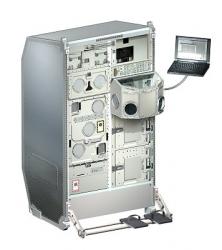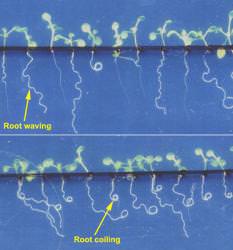The brand new ESA Columbus Module installed on the International Space Station (ISS) by the STS-122 crew last week is beginning a first run of biological experiments. This first experiment tests the reaction of root growth in different gravitational states. Of particular interest is how the roots of seeds develop in space when compared to terrestrial conditions. This has obvious applications for growing plants in space, underpinning agricultural science in some of the most extreme and challenging environments man will experience.
Today saw the first ever experiment on the ESA Columbus Module on board the ISS. European astronaut Léopold Eyharts activated the Waving and Coiling of Arabidopsis Roots at Different g-levels (WAICO) experiment, comparing two types of arabidopsis seed (one wild and one genetically modified) in gravity conditions from zero to one Earth gravity (or 1G). The arabidopsis seed is derived from the arabidopsis thaliana plant which copes very well in restricted space and thrives in hostile surroundings.

The WAICO experiment will last for 10 to 15 days and the sprouted seeds will be returned by the STS-123 Space Shuttle mission due for launch on March 11th so the results can be analysed. Throughout the experiment, using the brand new “Biolab” equipment (pictured), the advanced telemetry of the Columbus Module will relay real-time video of seed development to ESA scientists in Germany.
The development of the root growth will be scrutinized; especially the amount of “waving” and “coiling” that occurs as a reaction to different gravity conditions. These experiments will also help terrestrial farming methods, giving farmers the opportunity to optimize plant growing conditions.
Source: ESA


This seems to be such a (no pun intended) rudimentary experiment, done over, and over, and over, at the request of every grade school over all these years, just NOW they are looking at root development in space?
What am I missing?
What is different about this experiment?
I assume the difference is summed up in “…comparing two types of arabidopsis seed (one wild and one genetically modified) in gravity conditions from zero to one Earth gravity…”
Yes, the seed experiment seems to be repeated very frequently. I hope the ESA Laboratory isn’t just doing the same thing that Space Lab did many years ago.
Studying plant growth in space (on other planets, moons, or in designated spaceship labs) will definitely not be an overnight run. The arabidopsis has been a “lab rat” for plant research here on earth for some time due to its simplistic structure. Once the best and worst of the growth determinations have been found in such a simplistic plant, then the correction or help for any found problems might be easier to deal with in this litle thing. From there further work would be much more predefined for other plants perhaps.
At least, that is my opinion.
From ESA site: “… contribute to our knowledge of growing crops in the space environment – providing astronauts with nutritional fresh produce during a voyage that could last as long as two years.”
I don’t know so much about the earlier experiments and their objectives. At least the cosmonauts grew wheat seeds on Mir station, and Spacelab lentil.